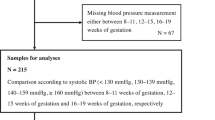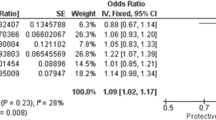Abstract
Blood pressure (BP) levels and body mass index (BMI) are known as risk factors for preeclampsia and gestational hypertension. However, there have been few investigations regarding the effects of BP and BMI levels on preeclampsia and gestational hypertension in the same cohort. In the present study, we conducted a retrospective cohort study using multiple logistic regression analysis. The cohort included 1,518 patients without nephritis. The unadjusted odds ratios (ORs) of preeclampsia and gestational hypertension were increased in pregnant women with normal BP (120–129 mmHg systolic or 80–84 mmHg diastolic), high-normal BP and hypertension in the second trimester compared to those with optimal BP. The unadjusted ORs of preeclampsia and gestational hypertension were also increased in obese women in the pre-pregnancy period compared to women with normal range BMI. When adjustment was made for both the BP levels and pre-pregnancy BMI levels, the ORs (95% confidence intervals) of normal BP, high-normal BP, hypertension and obesity for the subsequent occurrence of preeclampsia were 5.1 (2.2–12), 8.3 (3.1–22), 16 (5.0–50) and 2.0 (0.67–5.9), and those for the subsequent occurrence of gestational hypertension were 7.0 (2.6–19), 7.4 (2.1–25), 22 (6.1–83) and 1.3 (0.33–4.8), respectively. For the subsequent occurrence of preeclampsia or gestational hypertension, normal BP, high-normal BP and hypertension in the second trimester may be independent risk factors. Obesity in the pre-pregnancy period, however, may not be an independent risk factor.
Similar content being viewed by others
Article PDF
References
National High Blood Pressure Education Program Working Group: National High Blood Pressure Education Program working group report on hypertension in the elderly. Hypertension 1994; 23: 275–285.
Neaton JD, Wentworth D, for the Multiple Risk Factor Intervention Trial Research Group: Serum cholesterol, blood pressure, cigarette smoking, and death from coronary heart disease; overall findings and differences by age for 316,009 white men. Arch Intern Med 1992; 152: 56–64.
Saito I, Mori M, Shibata H, Hirose H, Tsujioka M, Kawabe H : Relation between blood pressure and rhinitis in a Japanese adolescent population. Hypertens Res 2003; 26: 961–963.
Hirose H, Saito I, Kawabe H, Saruta T : Insulin resistance and hypertension: seven-year follow-up study in middle-aged Japanese men (the KEIO study). Hypertens Res 2003; 26: 795–800.
Murayama S, Hirano T, Sakaue T, Okada K, Ikejiri R, Adachi M : Low-dose candesartan cilexetil prevents early kidney damage in type 2 diabetic patients with mildly elevated blood pressure. Hypertens Res 2003; 26: 453–458.
Kimura Y, Tomiyama H, Nishikawa E, et al: Characteristics of cardiovascular morphology and function in the high-normal subset of hypertension defined by JNC-VI recommendations. Hypertens Res 1999; 22: 291–295.
Joint National Committee on Prevention, Detection, Evaluation, and Treatment of High Blood Pressure : The sixth report of the Joint National Committee on Prevention, Detection, Evaluation, and Treatment of High Blood Pressure. Arch Intern Med 1997; 157: 2413–2446.
Committee on Japanese Society of Hypertension Guidelines for the Management of Hypertension : Blood pressure measurement and clinical evaluation, in Committee on Japanese Society of Hypertension Guidelines for the Management of Hypertension (ed): Guidelines for the Management of Hypertension (JSH 2004). Tokyo, Life Science Press, 2004, pp 7–15.
Chesley LC, Sibai BM : Clinical significance of elevated mean arterial pressure in the second trimester. Am J Obstet Gynecol 1988; 159: 275–279.
Iwasaki R, Ohkuchi A, Furuta I, et al: Relationship between blood pressure level in early pregnancy and subsequent changes in blood pressure during pregnancy. Acta Obstet Gynecol Scand 2002; 81: 918–925.
Ohkuchi A, Iwasaki R, Ojima T, et al: Increase in systolic blood pressure of > or = 30 mm Hg and/or diastolic blood pressure of > or = 15 mm Hg during pregnancy: is it pathologic? Hypertens Pregnancy 2003; 22: 275–285.
Tomoda S, Tamura T, Sudo Y, Ogita S : Effects of obesity on pregnant women: maternal hemodynamic change. Am J Perinatol 1996; 13: 73–78.
Thadhani R, Stampfer MJ, Hunter DJ, Manson JE, Solomon CG, Curhan GC : High body mass index and hypercholesterolemia: risk of hypertensive disorders of pregnancy. Obstet Gynecol 1999; 94: 543–550.
O'Brien TE, Ray JG, Chan WS : Maternal body mass index and the risk of preeclampsia: a systematic overview. Epidemiology 2003; 14: 368–374.
Masuo K, Mikami H, Ogihara T, Tuck ML : Differences in mechanisms between weight loss–sensitive and −resistant blood pressure reduction in obese subjects. Hypertens Res 2001; 24: 371–376.
Saito I, Murata K, Hirose H, Tsujioka M, Kawabe H : Relation between blood pressure control, body mass index, and intensity of medical treatment. Hypertens Res 2003; 26: 711–715.
Okosun IS, Boltri JM, Anochie LK, Chandra KM : Racial/ethnic differences in prehypertension in American adults: population and relative attributable risks of abdominal obesity. J Hum Hypertens 2004; 18: 849–855.
Tomoda S, Tamura T, Kitanaka T, Ogita S : First trimester biological markers for the prediction of pregnancy-induced hypertension. Am J Perinatol 1996; 13: 89–93.
Sato K : A proposal for a new definition and classification of “Pregnancy induced Hypertension (PIH)” (2004), in Japan Society for the Study of Toxemia of Pregnancy (ed): Historical Perspective of Study of Pregnancy-Induced Hypertension in Japan. Tokyo, Medical View Co, 2005, pp 54–87.
Moutquin JM, Rainville C, Giroux L, et al: A prospective study of blood pressure in pregnancy: prediction of preeclampsia. Am J Obstet Gynecol 1985; 151: 191–196.
Sibai BM, Gordon T, Thom E, et al: Risk factors for preeclampsia in healthy nulliparous women: a prospective multicenter study. The National Institute of Child Health and Human Development Network of Maternal-Fetal Medicine Units. Am J Obstet Gynecol 1995; 172: 642–648.
Author information
Authors and Affiliations
Corresponding author
Rights and permissions
About this article
Cite this article
Ohkuchi, A., Iwasaki, R., Suzuki, H. et al. Normal and High-Normal Blood Pressures, but Not Body Mass Index, Are Risk Factors for the Subsequent Occurrence of Both Preeclampsia and Gestational Hypertension: A Retrospective Cohort Study. Hypertens Res 29, 161–167 (2006). https://doi.org/10.1291/hypres.29.161
Received:
Accepted:
Issue date:
DOI: https://doi.org/10.1291/hypres.29.161
Keywords
This article is cited by
-
Development of preeclampsia in pregnant women with white-coat hypertension: a systematic review and meta-analysis
Archives of Gynecology and Obstetrics (2023)
-
Temporary hypertension and white coat hypertension in the first trimester as risk factors for preeclampsia
Hypertension Research (2019)
-
Galectin-1 as a novel risk factor for both gestational hypertension and preeclampsia, specifially its expression at a low level in the second trimester and a high level after onset
Hypertension Research (2018)
-
Prediction and prevention of hypertensive disorders of pregnancy
Hypertension Research (2017)
-
Parity as a factor affecting the white-coat effect in pregnant women: the BOSHI study
Hypertension Research (2015)



